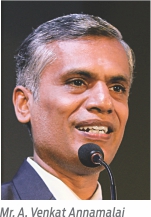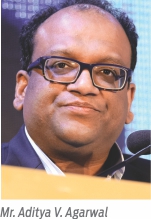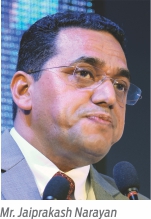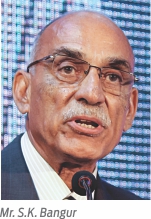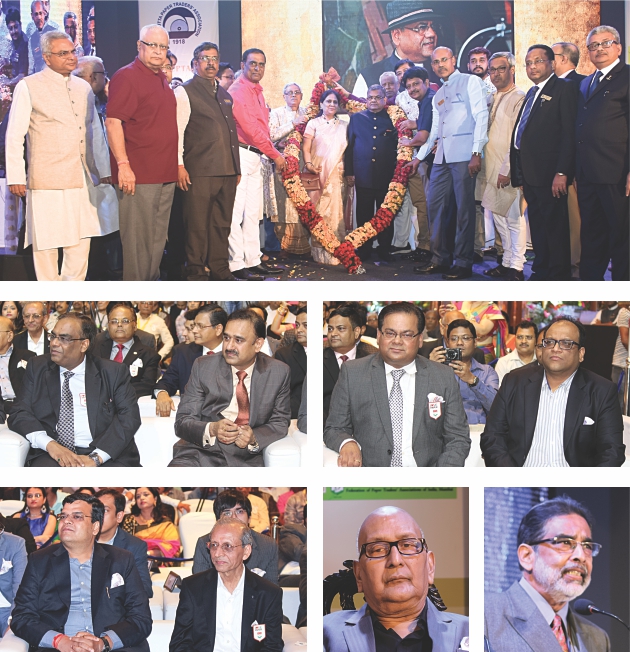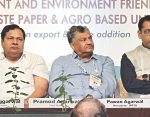FPTA organized its 57th AGM and Conference from August 18-20, 2018 in Kolkata. The conference was inaugurated to a full house represented by traders from every nook and corner of the country. The guest list included representatives from some of the top manufacturers to bring their perspectives to FPTA platform. Both traders and manufacturers agreed that Industry is in growth ascendance and they would need to work in sync in order to make the most out of it. The conference also discussed the global and national paper market scenario and deliberated on how to best position the Indian paper industry to ensure the continued growth momentum.
A Good Year for the Industry
Mr. A. Venkat Annamalai, Outgoing President, FPTA inaugurating the Conference said, “The year 2018-19 so far has been a notable year for the paper industry. We saw imports of varieties which was not present in the country such as uncoated woodfree paper and cut-sized copier. But during the year itself, we also saw drastic changes such as the soaring international pulp prices and the steeply weakening Indian currency against the US Dollar making imports uncompetitive and causing a downward trend in imports of pulp and such other products which made their way in the country. I however must compliment the fraternity of traders, which has managed the volatile situations with maturity.”
Mr. Annamalai stressed at the need to leverage the present growth phase in the industry through fair practices. “The trading fraternity as well as the paper manufacturers will both agree that the paper industry is doing fairly well. We need to make the most of this opportunity and try to make decent margins, which might be little difficult later. The opportunity is agreeable for all of us and we must not indulge in unhealthy competition amongst ourselves. We need to ensure we get fair margin for our work and investments,” he added. “I think now is the time to pull up our socks. If we don’t make decent margins now it will become difficult for us later. It is a golden opportunity for us. We should avoid unhealthy competition amongst ourselves and ensure that we get a fair margin for all our work, investments, and for the risk fraternity key.”
Mr. Annamalai lauded the work of FPTA in raising the traders’ issues and for its representation to the Govt. on salient issues. He said, “Talking about the activities of FPTA, I think of three Es – eventful, effective, and extraordinary. The FPTA has been eventful because of amazing participation from all our members. With effectiveness I mean our GST representation to the government to get all the paper products under one GST rate. We have expressed to the Finance Minister that the compliance would be better if there is a single GST rate. I am hopeful that this objective would be achieved with the cooperation from the entire paper industry. By extraordinary I mean that we have managed such effective events with the limited resources we have.
“We definitely need to convey to the world that paper is not a bad product as is the misconception. We must inform the whole paper industry that we as paper traders are absolutely ready to take this message to a large number of people.”
All Paper Segments Experiencing Good Growth
Mr. Aditya V. Agarwal, Director, Emami Group of Companies said, “Paper Traders Association is one of the key stakeholders of this industry and their contribution goes a long way in promoting better understanding across the stakeholders associated with this industry. They are representing their best interest at the right forums. I am delighted to be present here today and be a part of the 57th AGM of FPTA and the centenary celebration of Kolkata Paper Traders Association.
“I am sure most of the people have celebrated August 1, 2018, as Paper Day to position and promote paper as the only material that is biodegradable, renewable, recyclable, and sustainable. The reason why I am recalling this event is to clear the myth often being created by certain interest groups that use of paper means cutting of forests. This is not the case at all especially in India because the wood for the manufacturing of paper comes from cultivated trees grown by farmers. There is an all-around positive vibration throughout the paper and wood industry as well as the trade. This cheerful atmosphere shows that the paper as well as the trade industry is after a long run.
“All the segments of paper are experiencing good growth both locally and internationally. Amidst this scenario, Emami Paper, a part of the INR 60,000 Cr Emami Group, is well poised to leverage this growth story. We have never compromised on the product quality and the required investments to achieve that. Differentiation, innovation, and automation are the mantras of success. Hence, we went ahead with a diversification into a comparatively new area of consumer packaging board and met every required investment. Our newsprint and packaging board units at Balasore are testimonials of our commitment to raising the quality bar of paper products in India. Such latest trends and state-of-the-art technologies are what the industry demands today. India needs to emerge as one of the front-running nations producing the finest quality of paper and paper products.
“We all have to pitch in to achieve this target. This industry is poised to witness a significant growth in the coming years. This growth won’t be possible without the cooperation of traders, who are associated with this industry. Let’s strengthen our association and put the best foot forward for a brighter future of the paper industry in India.”
Traders, the Backbone of the Industry
Mr. Jyoti Kumar Bajaj, Managing Director, Krishna Tissues said, “The trader-manufacturer partnership in the industry is an enduring one. We will continue to support each other in the years to come. We have learned a lot from each other in the time of need and otherwise and this will continue in times to come. The dealers, distributors, and retailers network is extensive and a crucial part of the industry. The traders especially are the backbone of the industry whose role has increased immensely in the present scenario. The traders should bridge the gap between the consumers and the manufacturers by acting as consultants to the consumers on one side and manufacturers for the product development on the other.
“It is now the right time for the traders for going into the forward integration as demand for printing and packaging industry is on rise. The printing and packaging industry is growing by leaps and bounds. Simultaneously, the traders can go for the backward integration as well by investing in converting plants for the first delivery of goods to the consumers. Due to recent developments and restrictions imposed by the Chinese Govt., the market for paper and paperboards has opened all over the world. Now traders can reap the benefits of the opportunities available for exporting to other countries of the world.
“The future of the paper and paperboard industry is very bright. At present, the per capita consumption of paper and paperboard in India is around 12 Kg, which is way below the global average of 55 Kg. The Indian paper industry is growing at 6-7 percent year-on-year. The packaging industry is growing at a speed of 22 percent. The export of packaging products has also increased. The projected demand for the paper industry will be 20 million tonnes by 2020.
“There are myths surrounding the society regarding the paper. I would like to appeal to the paper manufacturers, traders, converters, publishers, printers, environmentalists, and NGOs to make a collective effort for promoting the paper and advocating the message that paper is biodegradable, recyclable, and eco-friendly. We have to encourage the public to make more use of paper and discourage them to use plastic.”
The Plastic Ban to Surge Paper Consumption
Mr. Jaiprakash Narayan, CEO, Century Pulp & Papers said, “Right now India has an overall demand of 21 million tonnes putting together all the segments. We are manufacturing somewhere around 15-16 million tonnes and remaining is getting imported. If you see the present scenario, the global manufacturing cost has gone up due to an excessive rise in pulp prices. At the same time, the dollar price has also gone up. The import in the country has reduced. At the same time, export for the manufacturers has become very attractive. There is much unmet demand in the country. As a result, this industry is witnessing a very good time both from the manufacturer’s and the trader’s perspective.
“If you see the future of this industry, we are anticipating that the future of this industry will be very good. However, it has got certain challenges. Due to the environmental pressure, not only in India but across the globe, people are moving towards biodegradable substitutes. The demand for plastic is around 30 million tonnes. If gradually the plastic goes off, approximately 40 percent of the plastic will be substituted by the paper based alternatives. Considering these factors, we are anticipating that the growth and future scenario of the paper industry including the traders will be very good.
“However, this future will be good only if manufacturers will take their role properly. We need to work with the latest technology, adopt the sustainable processes, and utilize the resources in a way that we can manufacture the product at global standards and at global manufacturing cost. If that be the scenario, I think manufacturers will be able to supply good products at a competitive price to all our traders. If the equation meets, I am sure the future of the manufacturers and traders will be very good.
“There is a new segment coming with the rise in the use of biodegradable products, i.e. tableware manufacturing. The pulp consumption is going up day by day. There are a lot of inquiries where people are asking for biodegradable pulp, especially agro-based pulp, for putting a machine to produce tableware coming. This product is related to mass consumption and if it comes into the market, it can be a new variant for the paper industry. This is possible and achievable only when we start connecting paper with innovation.”
FPTA and IPMA Must Form Lasting Association
Mr. S.K. Bangur, Chairman & MD, West Coast Paper Mills Ltd said, “FPTA is the apex association of the paper traders. They are providing good services to their members as well as to the paper industry. I want to convey my feelings to IPMA that they must remain in association with FPTA and actively participate in such programs. The traders have good interactions at the consumer level and they also try to interact at the industry level.
“I would also like to tell you that the industry is in talks with the government regarding the use of the degraded forest lands. In India, as per some estimate, about 3-4 million hectares of land are barren and not to put to any use. IPMA has proposed to the government that these lands can be given on lease to the paper industry for plantation purposes. The paper industry at its own cost would be planting trees which will help the industry as well as the ecology. In our country, several states have taken this step and other states would follow soon.
“The growth of the paper industry is around 6-7 percent, meaning an additional need of 7-8 lakh tonnes of capacity every year. To create such a capacity, we will be requiring an investment of around INR 5,000-7,000 Cr annually. We don’t know how the things will shape. Moreover, we can expect a modest growth if more states decide to ban plastics. The industry now has to think more pragmatically to understand how to implement capacity creation plans to take care of this expected growth of the demand.
“I would like to compliment the traders for a specific reason. When I compare the paper trade with the trade of other products, I feel the trading skill, the ingenuity, and the alertness which a paper trader requires are not required in many of the commodities. There are various categories of paper with each one having many sizes and multiple grammages. The paper may be a small product but it is a complex one and the trader has to deal with so many such products.”
Mr. S.K. Goenka, New President, FPTA thanked everyone present at the conference and said, “I would like to thank Mr. Annamalai, the outgoing President of FPTA, and all the members of FPTA. It is an honor for me to be chosen as the President of FPTA. I request the paper traders’ community to continue with their support to FPTA so that we all together can take the Indian paper trade to a new level. I dedicate my coming years in the service of FPTA.”



